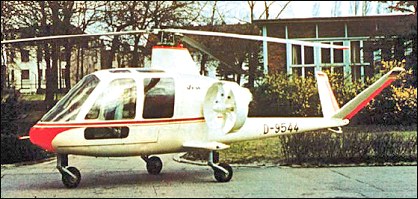
| VFW H-3 "Sprinter" 1968 |  |
 |

| VFW H-3 "Sprinter" 1968 |  |
 |
|
It all began in 1960 when VFW began research to develop a VTOL concept that exceeded the capabilities of current helicopters. More than a dozen different concepts were investigated, and the concept that evolved promising the best growth potential, productivity, speed, and cost effectiveness was the H3-E Compound Helicopter configuration. The H3-E was built with a mission as a three-seat executive transport, two-stretcher ambulance aircraft, or an agricultural system with a payload of up to 315kg. The design incorporated a compressed air and blade tip-drive rotor. The separate forward-thrust system consisted of fuselage-mounted fans. Sizewise, the H3-E had a fuselage length of 9.3m. The maximum height was 2.5m, which included the rotor head. The landing gear track was 2m, while the rotor disc area was 60m2. The H3-E was a three-seat craft which had a take-off weight of about 950kg and an empty weight of 500kg. The craft provided a payload weight of 265kg. The model had the capability of carrying a payload of almost 270kg with a fuel load of 205kg. The fuselage was built around an aluminum alloy load-bearing keel which supported the cabin, landing gear, and engine bay structure. The cabin skin was fabricated of a glass-fiber reinforced plastic laminate. The power unit was an Allison 400 shaft horsepower turbine engine which had a dual purpose. First, it was used to drive a centrifugal compressor in the hover mode. A duct delivered the compressed air through a flexible sleeve to the air distributor around the rotor shaft. Then, the high-pressure air traveled via flexible hose into the roots of the fully-articulated blades. The overhead rotor consisted of a three-blade configuration, had a diameter of just over 28 feet, and the blades used the NACA 23015 airfoil section. The speed range for the rotor varied from 280 to 480 revolutions per minute with a maximum loading of 15.7kg/m2. When the air reached the end of each rotor, it was thrust through flush-mounted slot nozzles. A state-of-the-art gearbox contained two bevel gears for the fans and a brake on the compressor shaft for switching the power to the compressor or to the fans. The mechanical layout of the system effectively eliminated the need for conventional transmission and driveshaft systems, hydraulic systems, and a tail rotor. The technique to achieve near-vertical flight occurred when the rotor was slightly rotated in a standard helicopter style. With the increase in speed, the side-mounted fans were caused to free-wheel within their containing shrouds. At a certain point in the trajectory, a decision that was made by the pilot, the transformation to full utilization of the fans could be made. Since the fans were already in a windmilling situation, the transition to full fan speed took only about two seconds to accomplish. Hovering stability was mainly affected by blade hinge offset, blade pitch, angular velocity, disk loading, gross weight and mass moment of inertia of the aircraft, The performance of the H3-E showed a capability of a maximum cruising speed of 250km/h with the normal cruising speed about 8km/h less. The maximum vertical rate of climb was carried as 2m/s, with a service ceiling of 3900m. Early in its program the H3-E underwent a number of test programs. An extensive blade fatigue test attempted to simulate the temperature and pressure cycles inside the blades. The test rig was fully automated, and every five minutes, the temperature and pressure increased and stabilized for 45 seconds before the blade vibrated. The only two prototypes of the H3 were constructed in 1968, with the first flight test occurring the following year. Before flight, though, there were considerable ground shake tests accomplished. A sophisticated test rig excited the rotor head with a constant force independent of frequency. Ground tests also showed that the vehicle had certain mechanical instabilities at high rotor speeds. S.Markman & B.Holder "Straight Up: A History of Vertical Flight", 2000
The H-2 (D-HIBY) was followed by a more sophisticated machine - the H-3 Sprinter which had a completely enclosed fuselage structure with a three-seat cabin, slim low-set tailboom with a V-tail, and a tricycle undercarriage. The powerplant was an Allison 250 turboshaft which, again, provided compressed air to the tips of the three rotor blades for vertical takeoff and also drove two large multi-blade ducted fan propellers mounted on the fuselage sides which provided forward power. The H-3 was further developed into the H-5 which was similar in layout but had a larger cabin with five seats. The first of two prototype H-3s (H3-E1, D-9543) flew in early 1970 without the external fan propulsion units. It was intended that the H-5 would be followed by the H-7 7/8 seater (construction of which was apparently started but not completed) and the much larger H-9. As it turned out, however, further development was abandoned in 1972 following the merger of VFW and Fokker. R.Simpson "Airlife's Helicopter and Rotorcraft", 1998
|